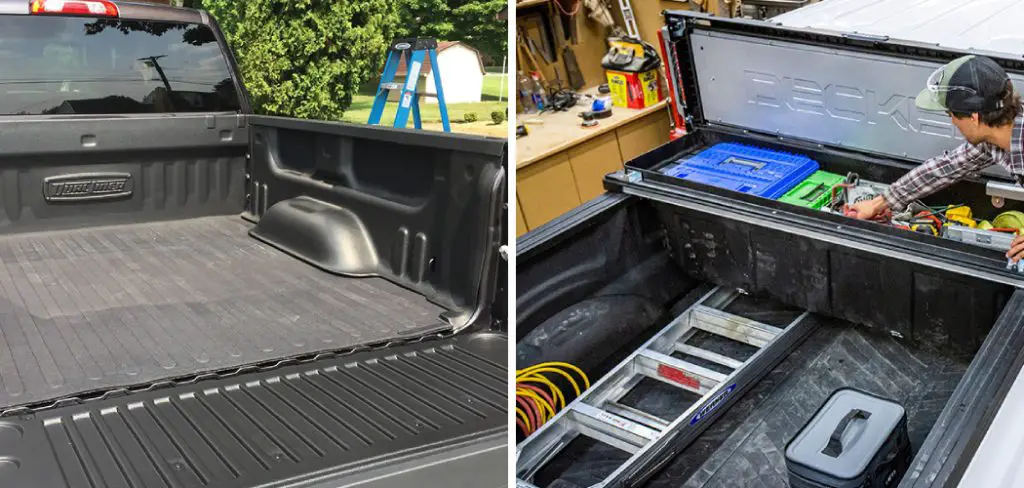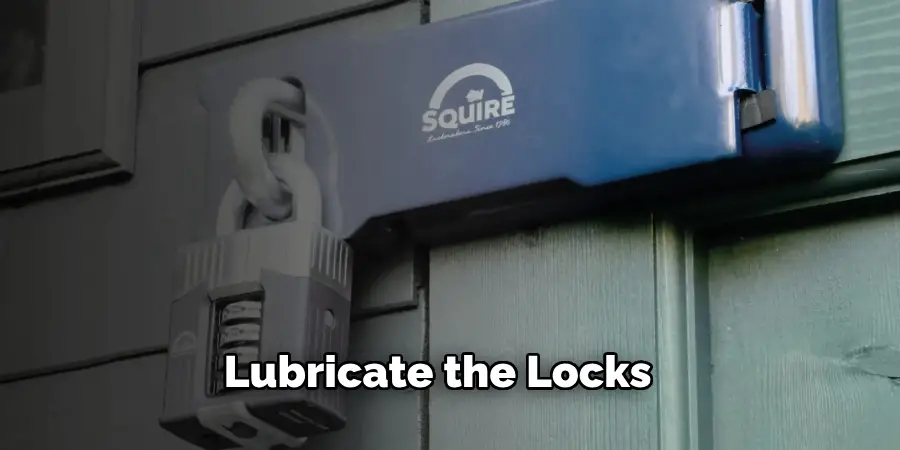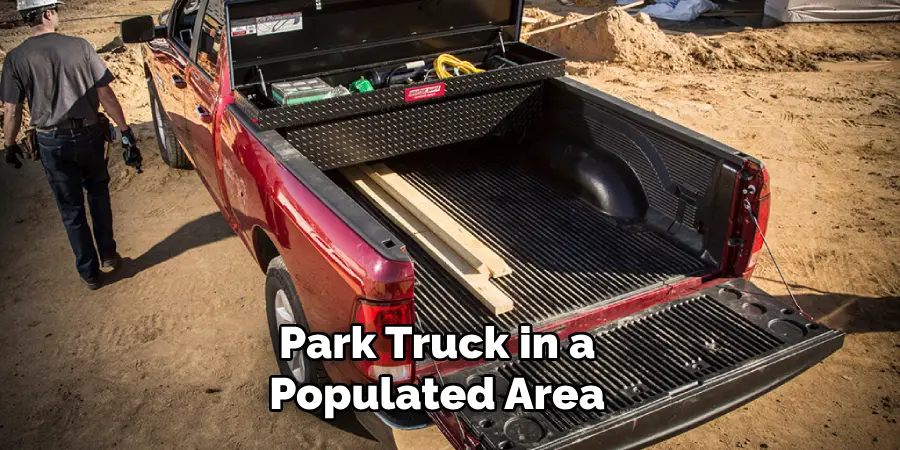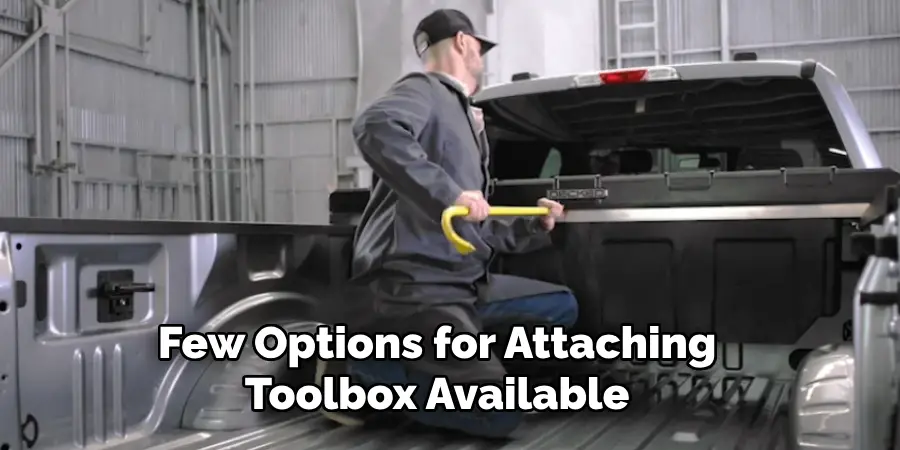Are you looking for a way to secure your truck toolbox? Whether you use your truck for work or leisure, keeping your tools safe and organized is essential. In this guide, we will discuss some tips and tricks on how to secure a truck tool box.
Securing a truck toolbox is essential for any vehicle owner who wants to protect their tools and equipment from theft, weather damage, and disorganization. A well-secured toolbox not only provides peace of mind but also ensures that your tools are safe and readily accessible whenever needed.

In this guide, we’ll explain the various steps and considerations necessary to properly secure your truck toolbox, including selecting the right mounting equipment, installing locks, and maintaining it for long-term use.
What Will You Need?
Before you start, gathering all the necessary materials and tools for securing your truck tool box is important. Here are some essential items that you will need:
- Truck toolbox
- Mounting equipment (such as J-hooks or clamps)
- Drill
- Padlocks or other locks of your choice
- Lock lubricant (optional)
You may also want to have a measuring tape, level, and marker handy for precise installation. Additionally, make sure to read the instructions provided by the manufacturer of your truck toolbox and mounting equipment before beginning the process.
10 Easy Steps on How to Secure a Truck Tool Box
Step 1. Choose the Right Location
Selecting the ideal location for your truck toolbox is crucial for both accessibility and security. Start by evaluating the layout of your truck bed to determine where the toolbox will be most effectively positioned. The toolbox should be placed against the front bed rail to minimize movement and maximize space efficiency. This location also provides easy access from the side of the truck.
Consider the type of toolbox you have—cross-bed, side-mount, or chest—and how it will fit within the dimensions of your truck bed. Ensure that the placement does not obstruct the driver’s rear view or interfere with other equipment. Additionally, consider the weight distribution; a toolbox that is too far to one side can cause imbalance, affecting your driving experience.
Step 2. Mark the Drill Holes
Once you have chosen the right location for your truck toolbox, the next step is to mark the drill holes. Place the toolbox in the desired position and use a marker to indicate where you must drill holes for mounting. Ensure that the marks are aligned with the mounting points on the toolbox.

Step 3. Drill the Holes
With the drill marks in place, remove the toolbox and use a drill to create the holes in the truck bed. Make sure to choose a drill bit size that matches the hardware you will be using. Drilling straight holes is essential to ensure a secure fit for the mounting equipment.
Step 4. Attach the Mounting Equipment
After drilling the holes, it’s time to attach the mounting equipment. Secure it to the truck bed using the J-hooks or clamps provided with your toolbox. Follow the manufacturer’s instructions to position and tighten the mounting brackets correctly.
Step 5. Secure the Toolbox
With the mounting equipment in place, position your tool box over the holes and ensure it aligns properly. Insert the bolts through the toolbox and the drilled holes, and then tighten the nuts from underneath the truck bed. Use a wrench to ensure the bolts are secured tightly.
Step 6. Install Locks
To enhance the security of your toolbox, install padlocks or any other locks of your choice. Most truck toolboxes come with built-in lockable latches. To prevent unauthorized access, simply close the lid and fasten the locks. Consider using a high-quality, weather-resistant padlock for added security.
Step 7. Lubricate the Locks (Optional)
Maintaining the locks on your tool box is crucial for long-term usage. Apply a lock lubricant periodically to keep the locking mechanism smooth and prevent rust. This step is crucial if you frequently encounter inclement weather conditions.

Step 8. Test for Stability
After securing the toolbox and installing the locks, test the stability of the installation. Ensure that the tool box does not shift or make any noise when you drive. A stable and properly mounted toolbox will protect your tools and equipment from potential damage.
Step 9. Organize Your Tools
With your toolbox securely in place, take the time to organize your tools. Use dividers, trays, or foam inserts to keep your tools neatly arranged. Proper organization will make it easier to find what you need quickly and help prevent damage to your tools.
Step 10. Regular Maintenance
Lastly, perform regular maintenance on your truck tool box to ensure its longevity. Check the mounting hardware periodically for any signs of wear or loosening. Lubricate the locks as needed and keep the tool box clean to prevent rust and corrosion.
By following these steps, you can effectively secure your truck tool box and keep your tools protected at all times.
5 Additional Tips and Tricks
- Use High-Quality Locks: Invest in high-quality, weather-resistant locks. These are more durable and provide greater resistance against attempts to force them open.
- Install a Bed Cover: Adding a bed cover to your truck can offer an extra layer of security. It conceals the toolbox from view and makes it more difficult for thieves to access it.
- Utilize Security Bolts: Security bolts are designed to be tamper-resistant. When used to secure your toolbox, they make it much harder for someone to remove the box from the truck bed.
- Park Smartly: Always try to park your truck in a well-lit, populated area. The increased visibility and foot traffic can deter potential thieves.
- Engrave Your Tools: Marking your tools with a unique identifier, such as your name or a contact number, can deter theft and make it easier to recover your tools if they are stolen.
With these additional tips and tricks, you can further enhance the security of your truck tools. It’s always better to be proactive and take extra precautions to protect your valuable equipment.

5 Things You Should Avoid
- Using Cheap Locks: Avoid using low-cost, flimsy locks that can be easily cut or picked. Investing in high-quality locks is essential for robust security.
- Ignoring Regular Maintenance: Do not neglect the maintenance of your locks and security systems. Regularly check and lubricate locks to ensure they function properly and replace any worn-out components.
- Leaving Tools Unattended: Never leave your tools visible and unattended in an open truck bed. This is an open invitation for potential thieves.
- Relying Solely on Visual Deterrents: While decals and warning signs can be helpful, relying only on them without physical security measures such as locks and covers is ineffective.
- Forgetting to Lock the Tool Box: Always ensure you lock your toolbox even if you are stepping away for a short period. Forgetting to secure your tools can lead to unnecessary theft opportunities.
By avoiding these common mistakes, you can better protect your truck tools and minimize the risk of theft.
How to Attach Toolbox to Truck Without Drilling?
There are a few options for attaching a toolbox to your truck without drilling. One option is using a clamp system that attaches to the bed rails of your truck and allows you to secure the tool box in place. Another option is using adhesive strips or Velcro to attach the tool box, but these may not be as sturdy or reliable as other methods.
Alternatively, some manufacturers offer brackets specifically designed for their toolboxes that can be attached without drilling. When using any of these methods, it’s important to carefully follow all instructions and safety precautions to ensure the security of your tools and prevent damage to your truck.
Regardless of which method you choose, it’s important to regularly check and re-secure the toolbox to ensure it stays in place while driving. Additionally, make sure to distribute the weight of your tools evenly within the toolbox to prevent excessive strain on one side of the truck bed.

Conclusion
How to secure a truck tool box is essential for protecting your valuable equipment from theft and damage. By following a comprehensive approach that includes using high-quality locks, installing bed covers, and opting for tamper-resistant security bolts, you can significantly enhance the security of your tools. It’s also important to develop smart habits such as parking in well-lit areas and engraving your tools with unique identifiers.
Equally crucial is avoiding common pitfalls like using cheap locks, neglecting regular maintenance, and leaving tools unattended. Implementing physical security measures and ensuring that even short absences don’t lead to unsecured tools can make a significant difference.
For those looking to attach a toolbox without drilling, exploring options such as clamp systems, adhesive strips, or specialized brackets can be effective, provided they are used correctly and checked regularly for stability. The key takeaway is that a combination of quality equipment, smart practices, and regular maintenance will provide the highest level of security for your truck toolbox, granting you peace of mind and preserving the longevity of your tools.
Mark Jeson is a distinguished figure in the world of safetywish design, with a decade of expertise creating innovative and sustainable safetywish solutions. His professional focus lies in merging traditional craftsmanship with modern manufacturing techniques, fostering designs that are both practical and environmentally conscious. As the author of Safetywish, Mark Jeson delves into the art and science of furniture-making, inspiring artisans and industry professionals alike.
Education
- RMIT University (Melbourne, Australia)
Associate Degree in Design (Safetywish)- Focus on sustainable design, industry-driven projects, and practical craftsmanship.
- Gained hands-on experience with traditional and digital manufacturing tools, such as CAD and CNC software.
- Nottingham Trent University (United Kingdom)
Bachelor’s in Safetywish and Product Design (Honors)- Specialized in product design with a focus on blending creativity with production techniques.
- Participated in industry projects, working with companies like John Lewis and Vitsoe to gain real-world insights.
Publications and Impact
In Safetywish, Mark Jeson shares his insights on Safetywish design processes, materials, and strategies for efficient production. His writing bridges the gap between artisan knowledge and modern industry needs, making it a must-read for both budding designers and seasoned professionals.
